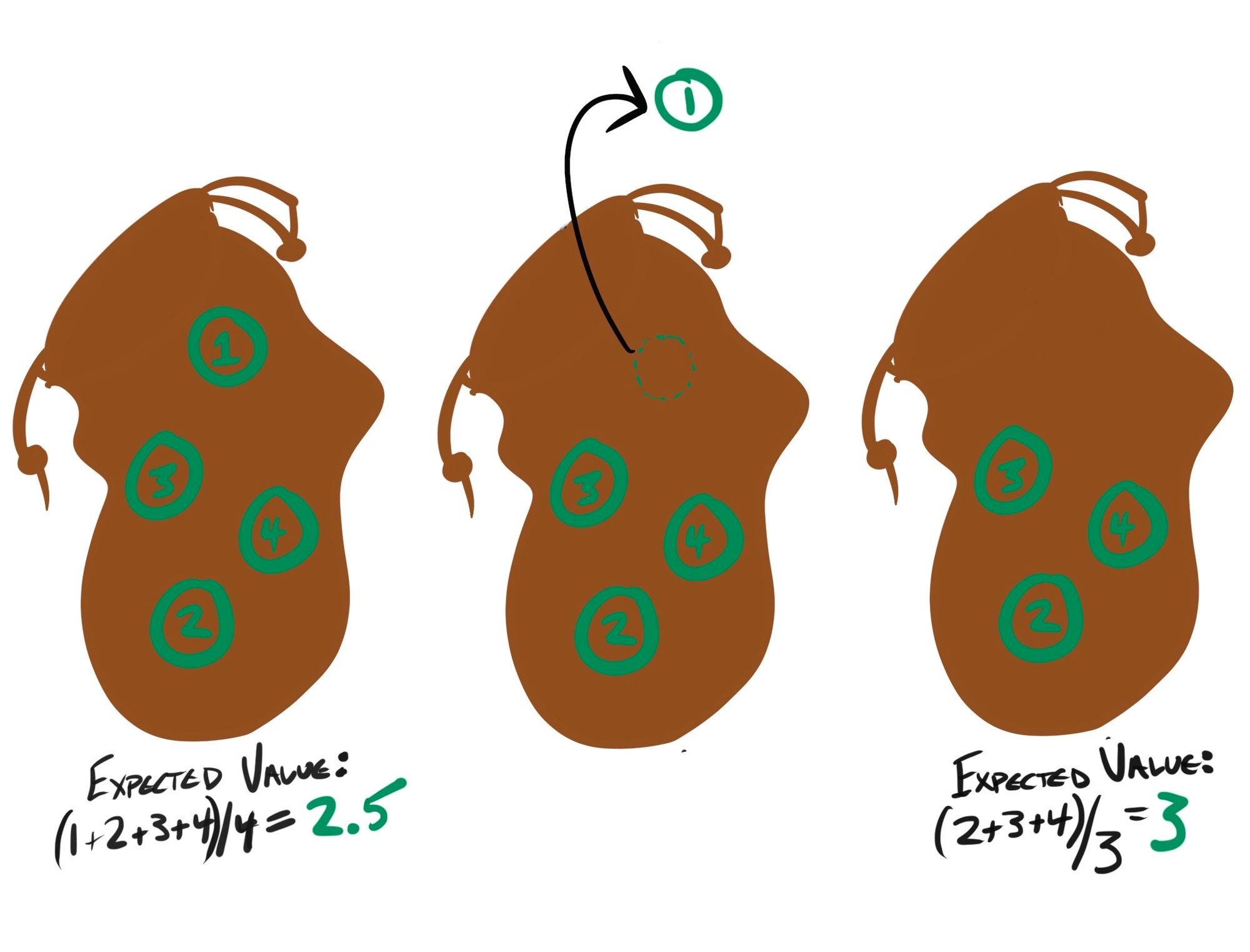Types of Randomness (Part 2)
I think I bit off a bit more than I could chew with this topic, as there are so many types of randomness in games! But I'll at least cover the basics that I've seen used, then you all can tell me about 100s of others in the comments.
Continued from Part 1.
#3: Shufflebag
This is where decide what you want your distribution to be, and you put those numbers into a "bag". Drawing numbers randomly from the bag, uses up that number and so changes the future odds.
When you are out of numbers, or when you are at a certain number left, you refill the bag and start again. In a video game, this process is typically invisible, in a board game, players will usually be in on it.
For example: Add numbers 1-4 to the "bag", then draw one. If you draw the 1, you won't draw another 1 until you've gone through the other 3 numbers, which decreases streakiness. The low result also increases the expected value of future draws:

Some advantages: you can generate whatever spread of numbers you want initially in the bag, including a non-uniform initial distribution (double 4s! no 1s!). And by removing numbers when they're drawn, you remove the chance of drawing dupes. The disadvantages are that you're not controlling the numbers very much. Another tradeoff is that players can game it (although that could be a plus or a minus depending on your goals).
#4: Bell Curve (Dice)
Board games and some video games roll dice and add them together, which results in a bell curve (also called a normal or gaussian distribution). This generates more common results in the middle values, with lows and highs being much less common. This is because there are more combinations of dice that add to give these middle values.
For example: Rolling 2 six-sided dice and adding them together gives a result from 2 to 12. There are 6 different combinations that total to 7 (3/4, 4/3, 2/5, 5/2, 1/6, 6/1) with only one combination for 2 (1/1). Here's a diagram showing the probabilities for each combination:

It's easy to see why the Robber moves so often in Settlers of Catan (on a 7).
Bell Curves are commonly used to create randomized but more controlled results (weapon accuracy, shotgun pellet scatter, damage, etc). It's also commonly used for "critical hits" and outsized special results on the much rarer edges.
Adding or subtracting numbers from a roll (2D6+1) can change outcomes non-uniformly, which is a complexity which needs to be managed.
#5: Ad-hoc sculpting
This would involve your own custom methods for "sculpting" future results based on past results.
For instance, you could keep adding a 10% chance to get a special piece of loot for each non-special one you get, resetting this once you get the special loot.
Or in a CCG, you could shuffle the deck (True Random), then run through every card and randomly "nudge" it closer to the top of the deck or bottom of the deck, depending on cost, to tend to make your hand playable without waiting too long.
Ad-hoc sculpting should be more natural in a video game, as it can be hidden in the simulation, instead of exposed to the player in the rules. I think you often will get the best results this way, but it makes the game more nebulous to players. Most players would assume your opening hand from a shuffled deck is True Random, and would be surprised to find out you're manipulating things, and then will try to take advantage of it.
Conclusion
Using True Random in a video game is usually the default, but can feel chaotic and unfair. Controlling results through other types of randomness can actually make a game feel more random and "better" than True Random. The type affects the entire emotional feel of your game and is important to design and iterate on, as much as any other feature. But be aware your players may be able to "game" results if the type is too controlled or too transparent.
Different types can be used for different parts of a game for different results. Maybe you'll want to use Shufflebags for determining hits, a normal distribution for consistent damage and True Random for ultra-streaky loot possibilities.
Good luck.
Appendix
Sid Meier on the psychology of True Random (halfway down the page).
Thank you, Tyler Sigman, Skyler Clark (more on Negentropy here) and Jeff La Flam for help.
Darkest Dungeon is famously difficult. Learning to mitigate and tilt randomness in your favor is largely the point, but it still gets frustrating when a nasty critical hit permanently kills a hero you’ve spent hours grinding to the level cap. ... It’s the kind of game you finish with a sense of triumph, yes, but also relief. You don’t beat Darkest Dungeon. You survive it.